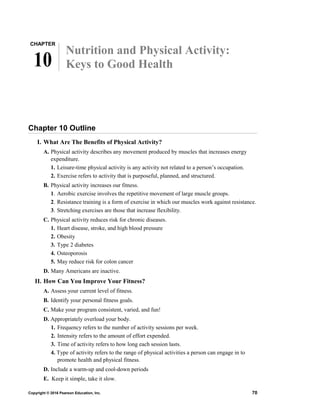More Related Content
Similar to Chapter 10 lecture outline (20)
More from Macomb Community College (20)
Chapter 10 lecture outline
- 1. CHAPTER
10
Nutrition and Physical Activity:
Keys to Good Health
Chapter 10 Outline
I. What Are The Benefits of Physical Activity?
A. Physical activity describes any movement produced by muscles that increases energy
expenditure.
1. Leisure-time physical activity is any activity not related to a person’s occupation.
2. Exercise refers to activity that is purposeful, planned, and structured.
B. Physical activity increases our fitness.
1. Aerobic exercise involves the repetitive movement of large muscle groups.
2. Resistance training is a form of exercise in which our muscles work against resistance.
3. Stretching exercises are those that increase flexibility.
C. Physical activity reduces risk for chronic diseases.
1. Heart disease, stroke, and high blood pressure
2. Obesity
3. Type 2 diabetes
4. Osteoporosis
5. May reduce risk for colon cancer
D. Many Americans are inactive.
II. How Can You Improve Your Fitness?
A. Assess your current level of fitness.
B. Identify your personal fitness goals.
C. Make your program consistent, varied, and fun!
D. Appropriately overload your body.
1. Frequency refers to the number of activity sessions per week.
2. Intensity refers to the amount of effort expended.
3. Time of activity refers to how long each session lasts.
4. Type of activity refers to the range of physical activities a person can engage in to
promote health and physical fitness.
D. Include a warm-up and cool-down periods
E. Keep it simple, take it slow.
Copyright © 2016 Pearson Education, Inc. 70
- 2. III. What Fuels Our Activities?
A. ATP is the energy molecule.
1. Creatine phosphate is a high-energy molecule used in muscles.
B. The breakdown of carbohydrates provides energy exercise.
1. Glycolysis is the breakdown of glucose.
2. To generate large amounts of ATP, oxygen is required for aerobic metabolism of
pyruvate.
C. Aerobic breakdown of fats supports exercise of low intensity and long duration.
1. Fat is an abundant energy source.
2. Fat provides 9 kcal of energy per gram.
3. Fat breakdown is a relatively slow process.
D. Amino acids are not major sources of fuel during exercise.
IV. What Kind of Diet Supports Physical Activity?
A. Vigorous exercise increases energy needs.
B. Carbohydrate needs increase for many active people.
1. An athlete’s diet should be between 45 and 65 percent carbohydrate.
2. Optimal glycogen replenishment occurs during the first few hours after exercise.
3. Whole grains, fruits, and vegetables are good sources of carbohydrates for athletes.
4. Some athletes may benefit from carbohydrate loading.
C. Moderate fat consumption is enough to support most activities.
D. Many athletes have increased protein needs.
E. Regular exercise increases our need for fluids.
1. Cooling mechanisms are needed to dissipate heat.
2. Dehydration and heat-related illnesses can occur.
3. Guidelines for proper fluid replacement are based on maintaining body weight.
F. Inadequate intake of some vitamins and minerals can diminish health and performance.
1. B-complex vitamins are directly involved in energy metabolism.
2. Athletes who do not consume adequate calcium may require supplementation.
3. Iron deficiency is a risk for some athletes.
V. Are Ergogenic Aids Necessary for Active People?
A. Anabolic products are promoted as muscle and strength enhancers.
1. Anabolic steroids are testosterone-based drugs.
2. Androstenedione and dehydroepiandrosterone are precursors of testosterone.
3. Gamma-hydroxybutyric acid has been promoted as an alternative to anabolic steroids
for building muscle.
4. Creatine is a supplement popular with strength and power athletes.
5. Protein and amino acid supplements are popular, but research indicates that they do
not build muscle.
B. Some products are said to optimize fuel use during exercise.
1. Caffeine is a stimulant and has been shown to increase the use of fat as a fuel during
endurance exercise.
71 INSTRUCTOR MANUAL FOR NUTRITION FOR LIFE, 4/e Copyright © 2016 Pearson Education, Inc.
- 3. 2. Ephedrine is a strong stimulant marketed as a weight-loss supplement and energy
enhancer.
3. Carnitine is a compound made from amino acids that is found in the mitochondrial
membrane of our cells.
4. Chromium is a trace mineral that enhances insulin’s actions.
5. Ribose is a five-carbon sugar that is critical to the production of ATP.
6. Beta-Alanine is a nonessential amino acid thought to delay the onset of muscle fatigue.
7. Nitric oxide is produced in the body by consuming a concentrate of foods high in
nitrate, such as beetroot, spinach, lettuce, arugula, celery, and watercress; recent
studies suggest that this supplementation could improve athletic performance.
Copyright © 2016 Pearson Education, Inc. CHAPTER 10 Nutrition and Physical Activity: Keys to Good Health 72

